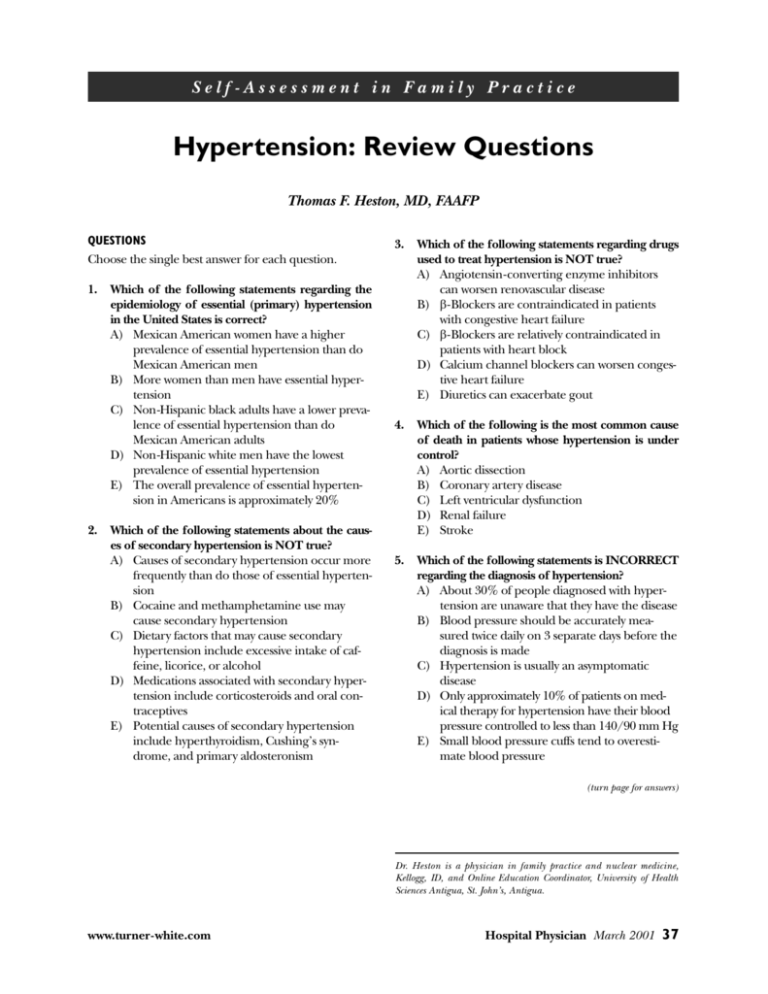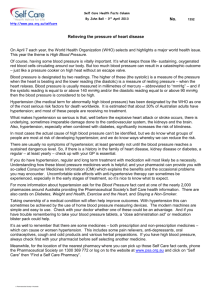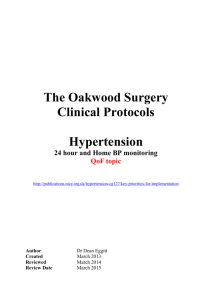
Self -Assessment in Family Practice
Hypertension: Review Questions
Thomas F. Heston, MD, FAAFP
QUESTIONS
Choose the single best answer for each question.
1.
2.
Which of the following statements regarding the
epidemiology of essential (primary) hypertension
in the United States is correct?
A) Mexican American women have a higher
prevalence of essential hypertension than do
Mexican American men
B) More women than men have essential hypertension
C) Non-Hispanic black adults have a lower prevalence of essential hypertension than do
Mexican American adults
D) Non-Hispanic white men have the lowest
prevalence of essential hypertension
E) The overall prevalence of essential hypertension in Americans is approximately 20%
Which of the following statements about the causes of secondary hypertension is NOT true?
A) Causes of secondary hypertension occur more
frequently than do those of essential hypertension
B) Cocaine and methamphetamine use may
cause secondary hypertension
C) Dietary factors that may cause secondary
hypertension include excessive intake of caffeine, licorice, or alcohol
D) Medications associated with secondary hypertension include corticosteroids and oral contraceptives
E) Potential causes of secondary hypertension
include hyperthyroidism, Cushing’s syndrome, and primary aldosteronism
3.
Which of the following statements regarding drugs
used to treat hypertension is NOT true?
A) Angiotensin-converting enzyme inhibitors
can worsen renovascular disease
B) β-Blockers are contraindicated in patients
with congestive heart failure
C) β-Blockers are relatively contraindicated in
patients with heart block
D) Calcium channel blockers can worsen congestive heart failure
E) Diuretics can exacerbate gout
4.
Which of the following is the most common cause
of death in patients whose hypertension is under
control?
A) Aortic dissection
B) Coronary artery disease
C) Left ventricular dysfunction
D) Renal failure
E) Stroke
5.
Which of the following statements is INCORRECT
regarding the diagnosis of hypertension?
A) About 30% of people diagnosed with hypertension are unaware that they have the disease
B) Blood pressure should be accurately measured twice daily on 3 separate days before the
diagnosis is made
C) Hypertension is usually an asymptomatic
disease
D) Only approximately 10% of patients on medical therapy for hypertension have their blood
pressure controlled to less than 140/90 mm Hg
E) Small blood pressure cuffs tend to overestimate blood pressure
(turn page for answers)
Dr. Heston is a physician in family practice and nuclear medicine,
Kellogg, ID, and Online Education Coordinator, University of Health
Sciences Antigua, St. John’s, Antigua.
www.turner-white.com
Hospital Physician March 2001
37
Self -Assessment in Family Practice : pp. 37 – 38
EXPLANATION OF ANSWERS
1. (B) More women than men have essential hypertension. Although the prevalence of essential hypertension in women is less than that in men, the actual
number of women with essential hypertension is
greater. Between 1988 and 1991, an estimated
21,900,000 American women and 21,287,000 men
had the condition. The age-adjusted prevalence of
essential hypertension is greatest in non-Hispanic
black adults (32%); in Mexican American adults, it
is 23%. Mexican Americans have a lower prevalence
of the disease than do white or black adults. NonHispanic white men have the lowest prevalence of
essential hypertension. The overall prevalence of
essential hypertension in Americans is approximately 25%.1
2. (A) Causes of secondary hypertension occur more
frequently than do those of essential hypertension.
Essential hypertension is much more common than
is secondary hypertension; approximately 90% of
cases of hypertension involve essential (primary)
hypertension.2 Both hyperthyroidism and hypothyroidism can cause secondary hypertension. Other
causes associated with secondary hypertension include renal parenchymal disease, coarctation of the
aorta, and renovascular disease.1
3. (B) β-Blockers are contraindicated in patients with
congestive heart failure. β-Blockers can be cautiously used in patients with congestive heart failure.
These agents improve diastolic relaxation and, as a
result, can improve cardiac output.2
4. (B) Coronary artery disease. Coronary artery disease
is the most common cause of death in patients whose
hypertension is under control. Hypertension is the
strongest risk factor for stroke, and 1 of the 3 main
risk factors for coronary atherosclerosis (the other
risk factors are smoking and hyperlipidemia). Hypertension can also lead to renal failure at a young age.
Uncontrolled hypertension causes increased left ventricular pressure, which over time can cause cardiomegaly and left ventricular dysfunction.1
5. (D) Only approximately 10% of patients on medical
therapy for hypertension have their blood pressure
controlled to less than 140/90 mm Hg. Approximately 25% of patients with known hypertension
have their condition under control. Multiple blood
pressure measurements should be obtained before
making the diagnosis. Several patients have labile
blood pressures, and experience “white coat hypertension” in the office. Although these patients are at
higher risk for developing sustained hypertension
later in life, they do not need medical treatment for
labile blood pressures alone. Hypertension is known
as “the silent killer,” because affected patients are
usually asymptomatic until complications occur.1
REFERENCES
1. Beers MH, Berkow R, editors. The Merck manual of
diagnosis and therapy. 17th ed. Whitehouse Station
(NJ): Merck Research Laboratories; 1999:1629–46.
2. Dambro MR, editor. Griffith’s 5-minute clinical consult.
Philadelphia: Lippincott Williams & Wilkins; 2000:528–9.
Copyright 2001 by Turner White Communications Inc., Wayne, PA. All rights reserved.
SELF-ASSESSMENT QUESTIONS ON THE WEB
Now you can access the entire Self-Assessment Series on the Web. Go to www.turner-white.com,
and click on the “Self-Assessment Questions” link.
38 Hospital Physician March 2001
www.turner-white.com







